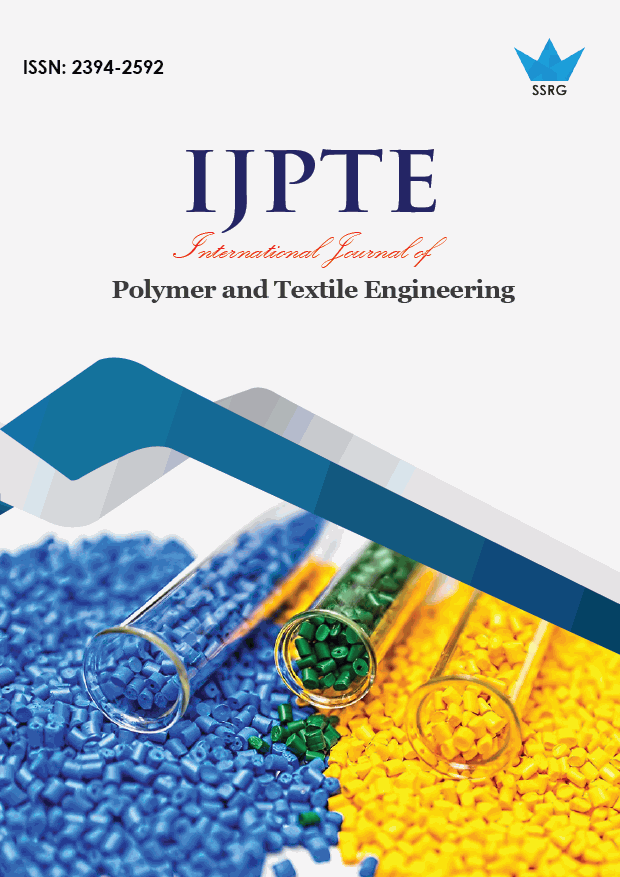Processing Methodology of Cotton and Fabrication of clothes in Textile Engineering

| International Journal of Polymer and Textile Engineering |
| © 2014 by SSRG - IJPTE Journal |
| Volume 1 Issue 1 |
| Year of Publication : 2014 |
| Authors : Dr.M.Arulananth |
How to Cite?
Dr.M.Arulananth, "Processing Methodology of Cotton and Fabrication of clothes in Textile Engineering," SSRG International Journal of Polymer and Textile Engineering, vol. 1, no. 1, pp. 10-13, 2014. Crossref, https://doi.org/10.14445/23942592/IJPTE-V1I1P104
Abstract:
In the textile manufacturing the conversion Is based on three types fabric, textile and yarn. And at last it will be fabricated into clothes and other artifacts. Since cotton is a natural fibre it plays a vital role in the textile manufacturing. Using that we can form different sorts of material with different kinds. This paper deals with the processing of cotton and how it undergone with the various manufacturing process. Which yeild the outcome as good artifact. Also this paper discuss about the processing of other vegetable fibers.
Keywords:
carding, ginning, cotton, spinning.
References:
[1] Collier, Ann M (1970), A Handbook of Textiles, Pergamon Press, p. 258, ISBN 0-08-018057-4.
[2] Gurr, Duncan; Hunt, Julian (1998), The Cotton Mills of Oldham, Oldham Education & Leisure, ISBN 0-902809-46-6.
[3] Nasmith, Joseph (1894), "Recent Cotton Mill Construction and Engineering", Recent Cotton Mill Construction and Engineering. (John Heywood, Deansgate, Manchester, and reprinted Elibron Classics), ISBN 1-4021-4558-6, retrieved 2009-01-11.
[4] Speccia, V., and A. Gianetto.1984. Powdered activated carbon in an activated sludge treatment. Water Res. 18:133-137.
[5] Watters, J.C., E. Biagtan, and O. Sener. 1991. Ultrafiltration of textile plant effluent. Sep. Sci. Technol. 26:1295-1313.
[6] Vanndevivera, P.C., and R.W. Bianchi. 1998. Treatment and reuse of wastewater from the textile wet-processing industry: review of emerging technologies. J. Chem. Technol. Biotechnol. 72: 289-302.
[7] Tang, C., and V. Chen. 2002. Nanofiltration of textile waste - water for water reuse. Desalination 143:11-20.
[8] Thilagavathi G., K. Rajendrakumar, T. Jeevarekha, and R. Rajendran. 2005. Cellulose enzyme softening. Textile Asia 36:1-32.
[9] Yu, S., C. Gao, H. Su, and M. Liu. 2001. Nanofiltration used for desalination and concentration in dye production. Desalination 140:97-100.
[10] Treffry-Goatley, K., C.A. Buckley, and G.R. Groves. 1983. Reverse osmosis treatment and reuse of textile dye house effluents. Desalination 47:313-320.
[11] Szymczyk, m., A. El-Shafei, and H.S. Freeman. 2007. Design, synthesis, and characterization of new iron-c Watters, ISSN: 2394 - 2592 www.internationaljournalssrg.org Page 13 J.C., E. Biagtan, and O. Sener. 1991. Ultrafiltration of textile plant effluent. Sep. Sci. Technol. 26:1295-1313.
[12] Vedavyasan, C.V. 2000. Combating water shortages with in- novative uses of membranes. Desalination 132: 345-347. complexed azo dyes. Dyes and Pigments 72:8-15.
[13] Sule, A.D., and M.K. Bardhan. 1999. Objective evaluation of feel and handle, appearance and tailorability of fabrics. Part
II: The KES-FB system of Kawabata. Colourage 46:23-28.
[14] x u, Y., R. l ebrun, P.J. Gallo, and P. Blond. 1999. Treatment of textile dye plant effluent by nanofiltration membrane. Sep. Sci. Technol. 34:2501-2519.
[15] Tinghui, l ., T. matsuura, and S. Sourirajan. 1983. complexed azo dyes. Dyes and Pigments 72:8-15. Effect of membrane materials and average pore sizes on
reverse osmosis separation of dyes. Ind. Eng. Chem. Prod. Res. Dev. 22:77-85.
[16] Zachariah, J. 1995. Kerosene recovery in textile printing. The Bombay Textile Research Association (BTRA), Bombay, India.

 10.14445/23942592/IJPTE-V1I1P104
10.14445/23942592/IJPTE-V1I1P104